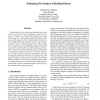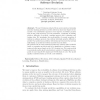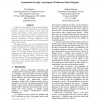48 search results - page 2 / 10 » DTS - A Software Defects Testing System |
HASE
1998
IEEE
13 years 9 months ago
1998
IEEE
Residual defects is one of the most important factors that allow one to decide if a piece of software is ready to be released. In theory, one can find all the defects and count th...
FASE
2007
Springer
13 years 11 months ago
2007
Springer
We use 63 features extracted from sources such as versioning and issue tracking systems to predict defects in short time frames of two months. Our multivariate approach covers aspe...
GECCO
2004
Springer
13 years 10 months ago
2004
Springer
Software systems are used regularly in safety-relevant applications. Therefore, the occurrence of critical defects may not only cause costly recalls but may also endanger human liv...
ICSM
2008
IEEE
13 years 11 months ago
2008
IEEE
In mission critical systems, such as those developed by NASA, it is very important that the test engineers properly recognize the severity of each issue they identify during testi...
ICST
2009
IEEE
13 years 11 months ago
2009
IEEE
Software products released into the field typically have some number of residual defects that either were not detected or could not have been detected during testing. This may be...



